Summer is finally here in north Idaho, and so far, the tomato crop is looking good. The normally cold and wet June weather proved to be mostly sunny and warm, giving way to lots of blossoms and fruit set on the tomatoes. Yay!
Still, we’ve experienced a couple of cooler than usual nights recently – some places saw temperatures in the upper 30°s (yikes). Inevitably there will be some tomato blossom drop as a result.
As we transition into true summer weather, it’s a good time to review a few tomato “conditions” you may see or experience throughout the growing season – especially if you are growing heirloom varieties. None of these are major issues, but gardeners often confused or misdiagnosed these as diseases or insect damage. Let’s take a look at a few common issues you’re likely to see if you’re growing tomatoes.
Blossom Drop
Here’s a fun fact…tomatoes don’t need pollinators (bees) to set fruit. They are “self-pollinating,” meaning they have perfect flowers with male and female reproductive parts. In fact, pollination often occurs before the flower blossom even opens! Bees and pollinators can help in the process of course, but by and large, the tomato takes care of its own business.
Blossom drop occurs when the flower of the tomato does not pollinate. Since it’s a self-pollinating species, why would this happen? The most common reason is a dip or extreme rise in temperatures and/or humidity.
Tomatoes are especially finicky, fair-weather plants that require specific weather conditions to pollinate and set fruit. The optimal conditions are temperatures between 70°F and 85°F, with an ideal humidity range between 40% and 70%. When temperatures are above or below these thresholds, or there is a radical temperature change, the flowers won’t pollinate. Blossoms then die and fall from the plant…and that’s blossom drop.
There are a few other cultural reasons this can happen, such as too much or too little water and/or fertilizer, or issues with insects – but most if the time it is related to the weather. Last year when the weather conditions were particularly bad, I wrote this detailed article about blossom drop.
To help prevent blossom drop use a floating row cover to protect plants when cool temperatures are predicted. Be aware of planting tomatoes next to walls or structures that will radiate excessive heat.
While it can be frustrating and a bit of a setback, your healthy tomato plants will continue to develop blossoms. Once the conditions return to the optimal pollinating temperatures, fruit will set and you’ll be back in business!
Blossom End Rot (BER)
First, BER is a physiological disorder – not a disease. It’s easily identified by the dark brown to black leathery spot on the blossom end of the tomato. The condition occurs from a calcium deficiency within the plant due to fluctuations in the plant’s water supply. Usually this happens when rapidly growing plants are exposed to a period of drought. However, it can also be triggered by excessive rains or over watering. Sometimes only one fruit on the flower bract will be affected – or just a few fruit on one side of the plant will exhibit the condition.
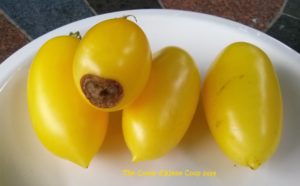
Roma and paste/sauce type tomatoes, like these ‘Cream Sausage’ are more prone to BER than other types of tomatoes.
Some tomato varieties are more prone to BER than others, these include many of the Roma or paste types, as well as the indeterminate sauce types, like the ‘Striped Roman’. I grow (and love) ‘Cream Sausage’, a pale yellow paste tomato, and I usually have one or two fruit each season that is affected by BER.
Of important note – BER has nothing to do with the amount of available calcium in the soil – it is related to the plant’s ability to take up calcium from the soil. Calcium isn’t a very mobile element in the plant, so even brief changes in the water supply can cause BER. Adding eggshells to your planting hole or using a foliar calcium spray won’t prevent BER.
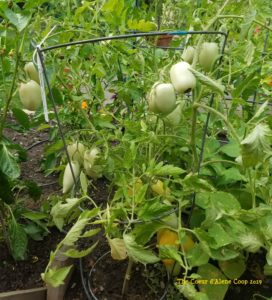
BER usually occurs early in the season. Usually only a few fruit are impacted. Here only one on the entire plant exhibits BER.
There are a few other causes of BER, including damage to the plant’s roots from cultivation; heavy, wet, cold soil (planting too early in the season!); excess soluble salt in the soil; and over-fertilizing with nitrogen.
While the condition is unsightly, the tomato can be salvaged by cutting the rotted end off. The remaining fruit is perfectly fine for consumption. In addition, seeds can be saved from BER tomato – but you’ll probably have better specimens to choose from later in the season.
To prevent BER, grow varieties that are less susceptible (or just be aware that it might happen with Roma types), mulch around the base of the plant to conserve soil moisture, and water regularly throughout the growing season.
Cat-Facing
Cat-facing is a term used to describe the sunken, deeply creased, brown, cork-like deformity found on the blossom end of the tomatoes. This is another physiological condition that is related to pollination and the weather.
Extended periods of cool daytime temperatures (60°F to 65°F degrees) and nighttime temperatures (50°F to 60°F degrees) can cause abnormal development and scarring of the forming fruit. It tends to be more prevalent in heirloom varieties, but has been known to happen in larger beefsteak hybrids. It is often found in fruit that is set early in the season when temperatures are more unstable.
Similar to a tomato with blossom end rot, a tomato scarred with cat-facing is perfectly fine to eat – just cut around the corking.
To avoid cat-facing you can delay planting until the weather conditions are more suitable (not that practical for our region); try growing smaller varieties; or choose varieties with smooth, round characteristics.
That would pretty much eliminate many of the spectacular heirloom varieties. Interestingly, back in the late 1800s, plant breeders were actively trying to breed out cat-facing. They desired smooth, round tomatoes – not the ugly, misshapen, and scarred heirlooms that we, once again, love today!
Zippering
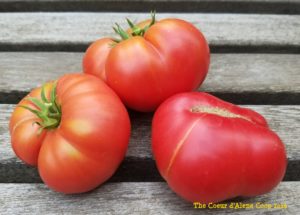
Zippering can be seen on these heirloom tomatoes. The tomato on the right also has a bit of cat-facing.
Have you ever noticed a seam-like scar or scars around your tomatoes? This is phenomenon is known as “zippering,” and again, it is a physiological condition caused by low temperatures during pollination. In this case, the anther of the tomato blossom becomes stuck to the newly forming fruit and creates a zipper-like scar around the fruit, usually from the blossom end to the stem. Sometimes the fruit will have a closed “hole” in it as well. Pretty freaky and Frankenstein-ish, but still perfectly safe to eat.
There really isn’t much you can do about this – except maybe enter it in the unusual vegetable category at the fair.
Fruit Cracking
Argh! How frustrating is it to find your prize beefsteak tomato split open on the vine! Tomatoes will crack, split, or burst when the internal growth of the fruit happens faster than that of the skin.
Cracks and splits can be radial (radiating out from the stem end) or concentric (around the fruit). Concentric cracks are usually the ones that cause the tomato to “burst.” Unfortunately, one of the main causes of cracking is genetics – some tomato varieties are just genetically predisposed to cracking.
It’s fairly common to see some cracking early in the season, especially on larger fruited varieties. These cracks often heal over without causing any problems to the fruit (other than cosmetic – there goes the blue ribbon). It’s when the tomato is nearly ripe – or ripe – that cracking can become a problem. Open splits or cracks can lead to disease development, rotting fruit, and an attractant to flies and yellowjackets.
Another common cracking cause is uneven moisture, either from over watering or excessive rainfall – especially during times of fruit ripening. Over-fertilizing can also lead to fruit cracking.
The best solution to prevent cracking is to grow varieties that are not prone to cracking; mulch around the plants to maintain even soil moisture; reduce watering as fruits begin to ripen; pick nearly ripe and ripe fruit when heavy rainfall is predicted; or do as I do, and just live with it – forgoing the blue ribbon yet again.
As the season progresses, you will no doubt experience a few of these conditions on your tomatoes. Do what you can to prevent these, but know that Mother Nature is the primary culprit. More importantly, your tomatoes will survive these conditions and still taste like summer on the vine!
Happy Gardening!
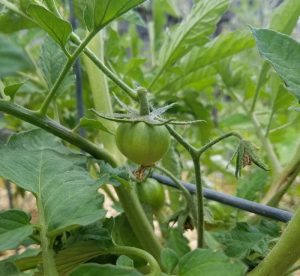
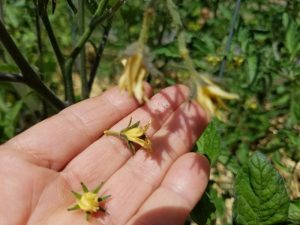
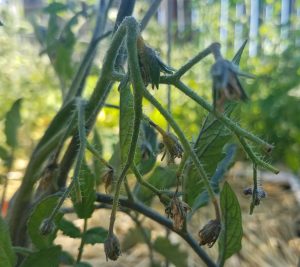
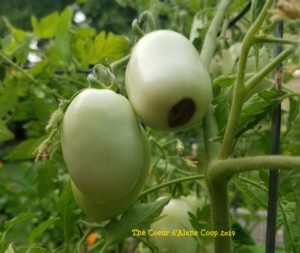
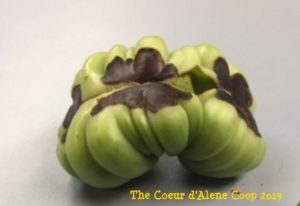
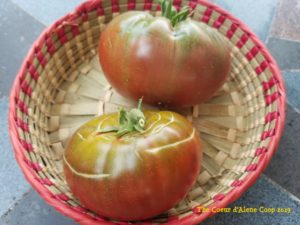
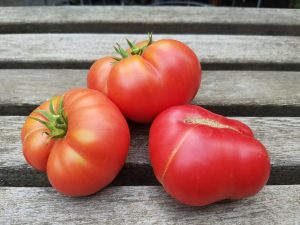


Leave a Reply